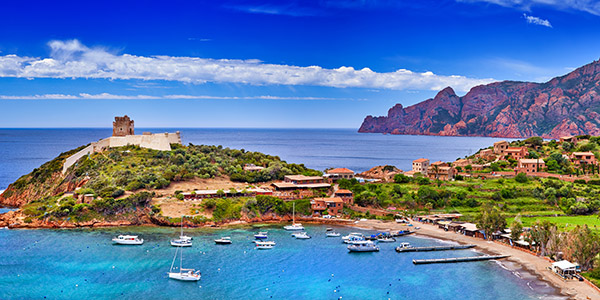On the other side of the gulf, come and discover the calanches (or calanques in French) of Piana, 7 km from Porto via a winding road but the spectacle is worth the detour! Contemplation can also be done from the sea, departing from Porto.
Porto
Porto is a hamlet in the village of Ota, which is located a little further up the valley. At the mouth of the river is the pebble beach of the gulf and the village. There are a few hotels and restaurants, and a Genoese tower. It is one of the only ones on the island to have been built in a square shape during the 16th century. The tower is open from April to September. The port of Porto is also the main departure point for boat excursions to the Calanches de Piana or the Scandola reserve, listed as a UNESCO World Heritage Site.
Ota
During its history, Ota was the most populated and developed area of the village. Away from the shore to protect itself from invaders, its main activity was agriculture. Traces can still be found today, with the presence of foothills towards Evisa. We also see the old mule tracks, the communication axes of the time which linked the villages of the valley.
Evisa
Perched at an altitude of 850 meters, Evisa is located on the edge of the Aïtone forest. The village is popular with hikers because it is a stopping point for the Mare e Moti and the starting/finishing point for the Mare aMare Nord which crosses the island from east to west. After crossing the village, the road continues towards the Col de Vergio which passes through the Aïtone forest. In winter a cross-country ski area is open and during the summer period, the “Aitone swimming pools” are appreciated by tourists and locals. On the other side of the pass, we arrive in the Niolo valley.
The Gulf (northern part)
North of the Gulf of Porto, on the D81 towards Calvi, we arrive at Bussaglia beach. It offers bathers a view of the Capu d’Ortu. Returning to the D81, we reach the village of Partinello and its bay of Caspiu 3km further down. For families, Gratelle beach, 5km further, is more suitable for children, because the waves are lower. Above the village of Osani, the Col de la Croix is the starting point for hikes in the region, and in particular towards the village of Girolata. The latter is only accessible by foot, for 3 hours round trip, or by sea. The walking trails towards Punta Castellacciu and a little further on Monte Senino offer hikers a magnificent view of the Gulf of Porto and Girolata. The Scandola nature reserve can only be visited by boat, from Calvi or Porto . The site has been under legal protection since 1975, due to its landscapes but also its fauna. The last pairs of ospreys on the island are located within the reserve. The site is also listed as a UNESCO World Heritage Site. The D81 continues towards the Col de la Palmarella and Galéria.
The Gulf (southern part)
The Porto – Piana road is one of the most beautiful in Corsica. A few kilometers after leaving the village, there is the possibility of parking your car, near a rock which has the shape of a dog’s head. This is the start of a hike towards the Castle, lasting approximately 40 minutes each way. back. The trail requires good equipment. Once arrived, we find a new point of view over Porto. Climbing enthusiasts will be able to benefit from a few drill hooks to practice their sport. The road through the Calanches stretches over 1.5km, don’t hesitate to stop to take a few photos of the panorama. The path oscillates between red granite rocks and green scrub, which contrast with the deep blue of the sea. One of the favorite spots for photos is near a hole formed by the heart-shaped rock. As the sun sets, many people stop to get the photo. Just before arriving at Piana, at the football square, another hike begins. It crosses the Dardo stream, and after two and a half hours of walking, arrives at Capu d’Oro (1294m above sea level) with a panorama of the region and the old mule path from Piana to Ota.
Piana
Piana is one of the most beautiful villages in France, notably thanks to its panorama of the Calanches. Above the village is the Belvedere of Saliccio which can be reached easily by car to enjoy a view over the Gulf of Porto. From the village, the D824 continues on a panoramic road, to reach other beaches. Just after leaving the hamlet of Vistale, the D624 branches off and leads to the bay of Ficajola. Returning to the D824, two kilometers further there is a snack bar near a car park and a hiking trail. A path leads towards the Genoese tower on Capu Rossu, and is one of the most beautiful on the island. The route takes approximately 3 and a half hours round trip. The trail is not shaded, it is necessary to leave quite early in the morning.
Gulf of Sagone
Arriving from the Gulf of Porto, we pass through Bocca di San Martino. Before arriving at Cargèse, on the D81, you have to go down a road towards the Gulf of Peru. At the end of the beach, the hike begins to get to the Genoese tower of Ominga. The path is well marked and it takes 2 hours there and back. The tower is not open to visits but remains in good condition. From the site, there is a view from Capu Rossu to the Sanguinaires Islands to the south.
Cargèse
Cargèse is a fishing and marina port on the west coast of Corsica. Its history was marked by the establishment of Greek colonies during the 17th century as well as in its surroundings, and has preserved testimonies in particular with its two churches, one Catholic in the Baroque style and the other, Greek of the Byzantine rite. Inside the first, you can enjoy the panorama of the surroundings of the village ! Before arriving in Sagone, the route passes by the beaches of Capizollu and Stagnoli. There is also another route, passing through the hinterland and the hamlet of Rondulinu. After crossing the village, on the right we find the Roman chapel of Saint-Jean and a UScumunicatu menhir statue. Continuing the path, we see a waterfall and 16km further we arrive on the D70 and the village of Sagone.
Sagone
The village is characterized by its cove and its beaches, notably one of the most beautiful in the Sagone region, Chiuni beach. 800m long, it is bordered by bushes and is suitable for children because the sea is shallow. The Liamone river is easy to access, where it is possible to park near the bridge. On the cultural side, the ruins of the Cathedral of Sant’Appiano are built on an ancient menhir and the site is open to visits.
Vico
Vico is at the foot of the Monte Retondo massif. Long a religious and political center of the western side of the island, the village was an active site of Corsican resistance against the Republic of Genoa during the 15th century. The Saint-François convent was built during this century, and has been restored several times.
Creno Lake
Lake Creno is at an altitude of 1,310m and is located in the middle of a pine forest. From Vico, head towards Murzo and Guagno-les-bains, on the D23, then Soccia. After crossing the village, the signs indicate “Lac de Creno”. The street ends in a square with a snack bar and a place where it is possible to rent donkeys. In summer, there are not enough parking spaces and it is advisable to come early in the morning. To get to the lake, it takes 3 hours round trip, for a difference in altitude of 300 meters. The village of Guagno-les-bains was known for being a place of cure, Napoleon III also stayed there. Since the end of the 90s, the site has been closed. The village is also a stopover on the Marea Mare Nord.


